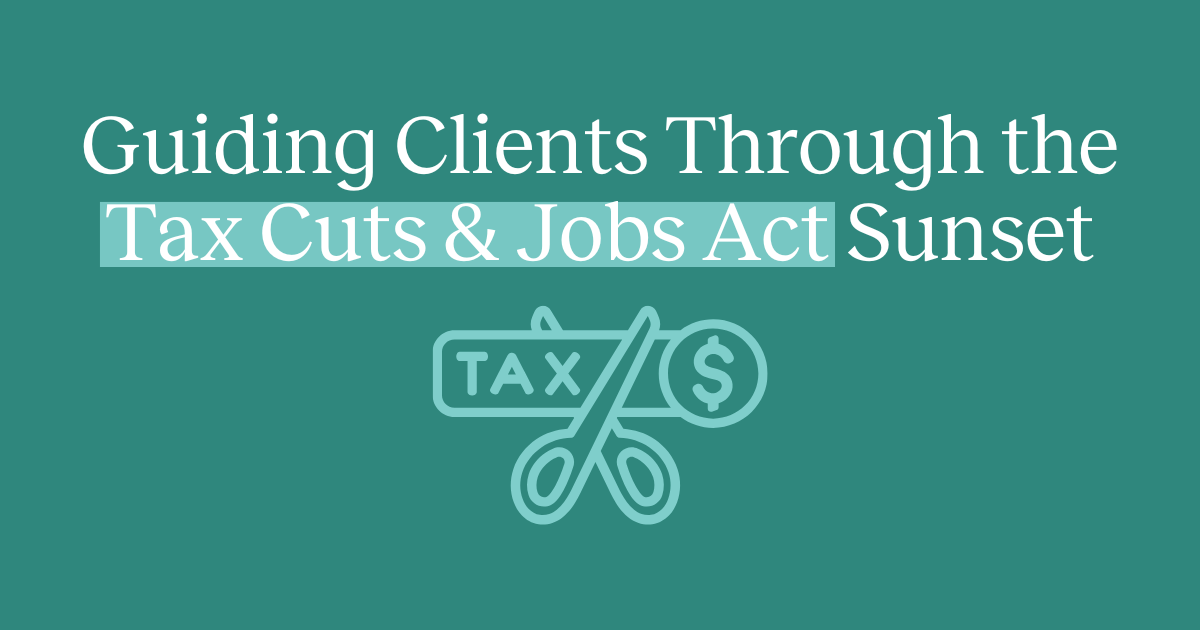As a financial advisor, helping your clients navigate the ever-changing tax landscape is a critical part of providing comprehensive wealth management services.
One major change on the horizon is the looming sunset of many provisions in the Tax Cuts & Jobs Act (TCJA) at the end of 2025, which could have significant implications for estate planning.
With trillions of dollars expected to pass between generations in the coming years as part of the “Great Wealth Transfer,” it’s imperative that advisors understand the potential impacts of the TCJA sunset and help clients plan accordingly, especially as it relates to their taxable estates.
In this post, we’ll dive into the key aspects of the TCJA sunset, explore who’s likely to be most impacted and outline estate planning strategies advisors can explore to ensure a smooth transition for their clients.
Understanding the potential Tax Cuts & Jobs Act sunset
The Tax Cut & Jobs Act, passed in December 2017, made sweeping changes to the U.S. tax code. However, many of the provisions affecting individuals and their estates are temporary, scheduled to expire on December 31, 2025 due to the budget reconciliation process used to pass the law.
Some of the most significant provisions set to expire include:
- Estate and gift tax exemption amounts reverting to pre-TCJA levels
- Individual income tax rate increases
- Reduction of the qualified business income (QBI) deduction for pass-through entities
- Lowering of the alternative minimum tax (AMT) exemption amounts
Unless Congress takes action to extend these provisions, the tax code will revert to its pre-2018 state, which could have major ramifications for high-net-worth individuals and families and their estate plans.
Who will be affected?
The TCJA sunset will primarily impact high-net-worth individuals and families—those with assets exceeding the post-sunset exemption amounts. This may include clients who hadn’t previously needed to worry about estate taxes but have seen their wealth grow in recent years and are now in danger of surpassing the lifetime exemption amount.
Certain individuals, like business owners or those with highly-appreciated assets, may be particularly susceptible to the impacts of the reduced exemptions. Blended families and unmarried couples could also face unique challenges and may require more complex planning.
That said, even clients below the exemption thresholds should review their financial plans, as there could be state-level tax consequences to consider. Plus, life circumstances change—what may not be an issue today could become one down the road.
The biggest potential changes of the TCJA sunset
Here’s a look at some of the biggest pending changes and how advisors can prepare.
Estate & gift tax exemption: Use it before you lose it
Perhaps the most talked-about aspect of the TCJA sunset is the impending reduction in the lifetime estate and gift tax exemption. Currently, individuals can transfer up to $13.99 million ($27.98 million for married couples) in their lifetime without incurring federal estate or gift taxes due to the TCJA. It’s important to clarify that this lifetime exemption amount is separate from the annual gift tax exclusion, which allows individuals to gift up to $19,000 per recipient in 2025 without counting towards their lifetime exemption.
But this historically high lifetime exemption means that currently, only a small amount of estates are subject to federal estate tax.
That could change dramatically in 2026, when the exemption is set to drop back down to around $7 million per individual, adjusted for inflation. Suddenly, many individuals who didn’t have taxable estates will be at risk of owing substantial estate taxes, ranging from 18% to 40% on the value exceeding the exemption amount.
This potential change is most relevant to clients who have been relying on elevated exemptions for their estate plans—those with substantial wealth and assets to pass down. Advisors need to be proactive in developing strategies to minimize estate tax exposure, which could include:
- Gifting appreciating assets: Clients can take advantage of the current exemption by gifting appreciating assets, like stocks or real estate, to irrevocable trusts or directly to beneficiaries. The IRS has confirmed there will be no clawback for gifts made under the current exemption, even if the exemption is lower at the time of the donor’s death. This allows clients to remove asset appreciation from their taxable estates.
- Spousal Lifetime Access Trusts (SLATs): For married clients hesitant about giving up access to gifted assets, SLATs can provide a solution. One spouse funds an irrevocable trust for the benefit of the other, using their gift tax exemption. The beneficiary’s spouse can still access the funds if needed, offering flexibility and peace of mind.
- Grantor Retained Annuity Trusts (GRATs): GRATs allow clients to transfer assets to an irrevocable trust while retaining the right to receive annuity payments for a set term. If structured properly, appreciation beyond the IRS Section 7520 rate passes to beneficiaries tax-free at the end of the term.
- Charitable giving: The TCJA also raised the charitable deduction limit. Taxpayers who itemize can deduct up to 60% of their adjusted gross income—previously they could only deduct up to 50%. Clients who are considering a large charitable donation as part of their estate plan may want to act now before the limit reverts.
It’s important to weigh the trade-offs of these strategies. Gifting to irrevocable trusts can create long-term estate tax benefits, but advisors must carefully evaluate potential drawbacks. Relinquishing control and losing the step-up in basis at death could result in a substantial capital gains tax burden for heirs if the exemption doesn’t ultimately drop as expected or the client’s wealth ends up below the threshold.
Changing income tax rates could impact estate planning decisions
In addition to estate planning considerations, the TCJA sunset will impact clients’ income tax pictures. Tax rates are scheduled to increase across the board, with the top marginal rate rising from 37% to 39.6% and most brackets seeing a lowering of their income thresholds.
Here’s a closer look at how individual tax brackets will change:
After the TCJA sunset, more individuals and married couples will find themselves in higher tax brackets. Depending on their overall financial picture, it might make sense for certain clients to incur taxes at today’s lower rates for the later benefit of their beneficiaries.
For clients in these affected brackets, advisors may want to explore strategies to accelerate income recognition while rates remain relatively low. Options to consider include:
- Roth conversions: With tax rates poised to rise, Roth conversions become increasingly attractive. By converting pre-tax retirement accounts to Roth IRAs, clients pay tax on the converted amount now in exchange for tax-free withdrawals later. This can be especially smart for clients who expect to be in a higher bracket in retirement.
- Harvesting capital gains: Clients sitting on highly appreciated assets may benefit from selling and recognizing gains before rates increase. Advisors can help clients identify opportunities to strategically offset realized gains with available losses.
- Accelerating business income: Business owners expecting strong profits in the coming years might consider shifting income recognition forward to take advantage of current rates. Advisors can collaborate with CPAs to develop timing strategies around invoicing, collections and expenses.
Phaseouts of business income deduction and AMT exemption may increase taxable estates
Two other notable provisions sunsetting in 2025 are the 20% qualified business income (QBI) deduction and the expanded alternative minimum tax (AMT) exemption amounts. While these changes have broad financial planning implications, they can also impact estate planning by potentially increasing a client’s taxable estate.
With the loss of the qualified business income (QBI) deduction, affected business owners could see a jump in their taxable income, which may push them into a higher bracket and over the estate tax exemption. Advisors should work with these clients’ CPAs to explore entity restructuring to manage income tax liability and potentially preserve estate tax exemptions.
Similarly, the AMT may ensnare many more taxpayers post-2025, as the exemption amounts will revert to their much lower pre-TCJA levels. Common AMT triggers like high state and local taxes, significant capital gains, and incentive stock option exercises could inflate a client’s taxable estate. Advisors may want to encourage clients to accelerate income and exercise ISOs while the expanded AMT exemption remains.
Flexibility is key in an uncertain future
With any planning around future tax changes, the only certainty is uncertainty. It’s impossible to predict exactly what the legislative landscape will look like in 2026 and beyond.
It’s possible that many parts of the TCJA could be extended by Congress before the 2025 sunset. However, given the current political landscape and growing national debt, many experts view this as unlikely.
Even if an extension does occur, it may not be permanent. This creates an environment of uncertainty that makes long-term planning difficult—the approach for advisors and clients should be to hope for the best but plan for the worst.
That’s why, above all, advisors should prioritize flexibility in their clients’ estate and tax planning. Rigid strategies based on current law could backfire if the rules change unexpectedly. Instead, focus on crafting nimble plans that can be easily adjusted as circumstances change.
Some key ways to build flexibility into client plans include:
- Revocable trusts: Unlike irrevocable trusts, revocable living trusts can be freely amended or revoked by the grantor during their lifetime. This allows clients to modify their plans as needed without losing control of trust assets.
- Disclaimers & powers of appointment: Including disclaimer provisions and powers of appointment in estate planning documents gives beneficiaries the ability to adjust inheritances based on the prevailing tax environment. This can help optimize tax outcomes without locking clients into an inflexible structure.
- Regular plan reviews: Advisors should commit to meeting with clients at least annually to review estate plans and tax strategies. Regular check-ins provide opportunities to assess how changing laws and circumstances may impact clients’ plans and make proactive adjustments.
Ultimately, the key to navigating the TCJA sunset successfully is to stay informed, start planning conversations early and remain adaptable. By taking a proactive approach, advisors can strengthen client relationships and cement their value as trusted guides through an uncertain tax landscape.
See why advisors and clients love Wealth.com
Get a Demo


